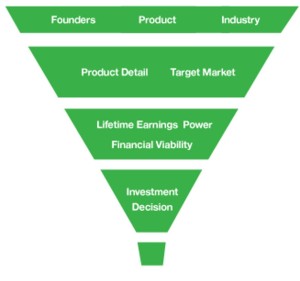Due Diligence[1]
Broadly defined, due diligence is a comprehensive review or investigation of material facts in regards to an investment or transaction. Typically, buyers execute an extensive due diligence process prior to consummating the purchase of a business or investment to gain a full understanding of the both the assets being acquired as well as any liabilities or risks inherent in the business or transaction.
In the context of startup investing, the goal of due diligence is to evaluate the economic viability of an idea or early stage business, and it typically occurs through multiple phases or steps. Despite investing at different points in a company’s life or specializing in investments within specific industries or markets, venture capitalists typically employ a comprehensive screening system to determine whether a company or investment is appropriate for the fund’s portfolio. A phased approach to due diligence provides investors with a structured process for evaluating each investment opportunity against standard criteria.
As investors eliminate companies at various stages in the screening process, a group of over 100 prospective investments might result in one or two companies ultimately receiving an
investment.

The diagram here serves as an example of a due diligence process culminating in an investment decision for early and seed stage venture capital funds.
Phase I
A typical first screen involves a detailed look at the founding team, the company’s product or service, and the industry in which the company will be operating. These three criteria provide a solid foundation for the initial screening process and can help bring to light any red flags early in the review process.
Founding Team: When evaluating a founding team, importance is placed on a team’s relevance to the product or market. For example, if founders have established a company to tackle problems related to DNA sequencing yet prior experience is in social media, a deeper look into the team’s motivations and understanding of its target market would be warranted. However, if the founding team is a group of scientists with experience in biomedical engineering and DNA research, a direct link can be made between the team and the product. In addition to product knowledge, background checks and interviews serve an important role in screening a founding team.
Product or Service: In the initial screen, evaluation of the product or service is focused on its broad application and understanding why a certain product or service is necessary, what void is being filled by its existence, and when will broad adoption occur. Most investors conduct a product demo to confirm the product works as advertised and assess the user or customer experience.
Industry: Industry analysis sets the stage for understanding a company’s target market, key demographics, existing competitors, barriers to entry, and voids the company is trying to alleviate. This analysis provides context for the remaining steps in the review process and helps investors prepare for a detailed review of the product.
Phase II
For companies that move beyond the first filter, Phase II involves a deeper evaluation of the product and the specific market the company is targeting.
Product Detail: In Phase II, a company’s product is sent through an exhaustive review process with investors basically attempting to poke holes in the company’s product thesis from multiple angles. This process includes an analysis of the core technology, its scalability and adaptability, and the product roadmap and milestone timelines. A lot of attention is paid to the user experience and user interface. Questions are typically answered regarding the product’s usability, ease of adoption, any friction points, and specific use cases. In addition to experience, focus is placed on the user interface and design of the product. Investors determine whether the design is appropriate for the target market or unique relative to existing competitors. In addition to review and analysis of the core product, investors also conduct a review of the prospective business model and monetization channels.
Target Market: When evaluating a company’s target market, sometimes referred to as the “total addressable market” or “TAM,” several key factors play a role. From the investor’s perspective, a target market analysis boils down to an understanding of the company’s prospective customers: demographics, propensity to spend, size of customer base, built-in network effects, employment and earnings power, and regional economic factors, among other considerations. This analysis varies between consumer and enterprise end-users as well as software or hardware products. It’s also important to review how a company measures its addressable market, which can serve as a barometer of a company’s understanding of its customers. If large variances exist between an investor’s independent analysis and a company’s depiction, further study should be done to either reconcile differences or confirm a company’s mischaracterization of its customer base.
Phase III
Phase III closes the loop on the analysis thus far, tying together the product and customer base to determine a company’s economic viability and revenue-generating capacity. Utilizing information discerned in the prior two filters, investors can properly evaluate the economic merit and commercialization of the company by combining what was learned from the product analysis, business model, and customer base. These three items, when taken together, can serve as the basis for understanding a company’s earnings power from both a single customer and aggregate market perspective. In addition to revenue generation, detailed attention is paid to a company’s cost structure to ensure appropriateness for the product. For example, a hardware company will have a higher cost structure due to expenses related to components and manufacturing relative to software companies where the bulk of expenses is typically found in salaries and wages. Ultimately, revenue generation driven by market adoption of a superior product is what will drive a given company’s success. Phase III of the due diligence process sets out to quantify this potential in an effort to initiate an investment decision.
Phase IV
The due diligence process culminates in an investment decision made after the investor has reviewed all material facts relating to a company, its product, and market. Several other investor-specific factors can influence an investment decision, including familiarity with the industry or strategic fit within a portfolio.
Why is Due Diligence Important?
Due diligence, when conducted properly, can be a time-consuming and painstaking process. However, the importance of due diligence cannot be overstated. With barriers to capital formation for startups being liberated through crowdfunding, and general growth and awareness of startup communities around the world, individual investors are overwhelmed with opportunities to put capital to work into a variety of new business ventures. Given risks inherent in startup investing, investors need to take the proper steps in evaluating investment opportunities. A rigorous due diligence process can help illuminate the risks of a given investment opportunity and assist investors in making an informed decision as to whether an investment is appropriate for his or her portfolio.
[1] The entire information provided is purely educational and is not a representation of any processes used or recommended by eleva8or and is accumulated from various third party resources.
